Burke's Station
Introduction
Text-to-speech Audio
Images
The Burke's Station building in 2005
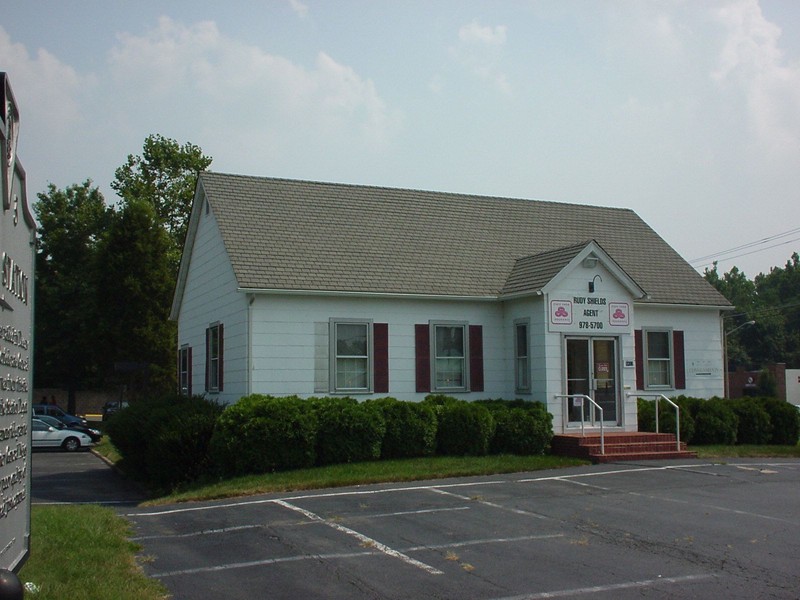
The Burke's Station building in 2015
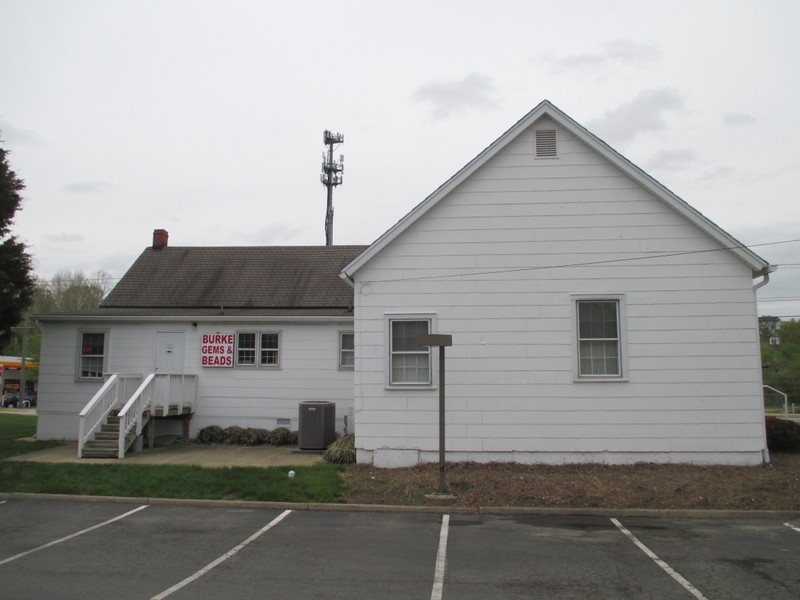
"Burke's Station: The Christmas Raid" Civil War Trails sign at the Burke Station site
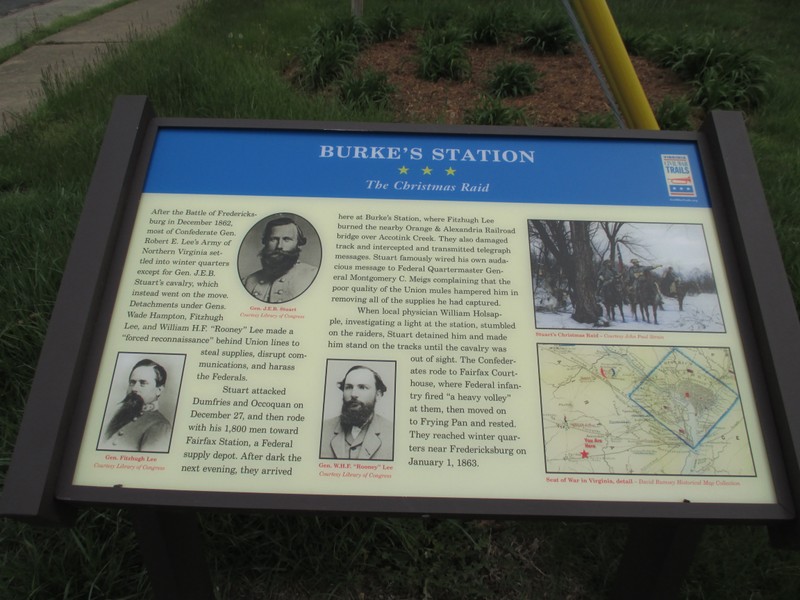
"Burke Station" marker at the Burke's Station site
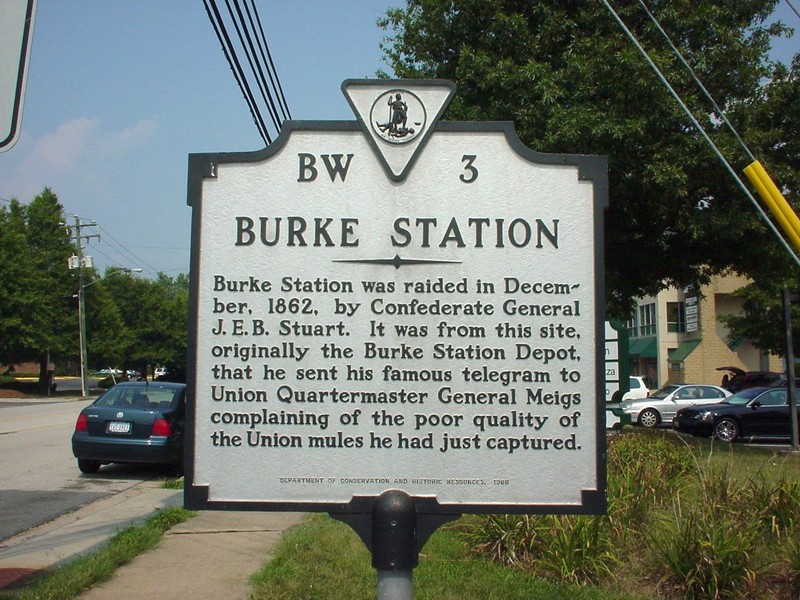
"Burke's Station: Wood Choppers and Teamsters" Civil War Trails sign about 400 feet from the Burke Station site
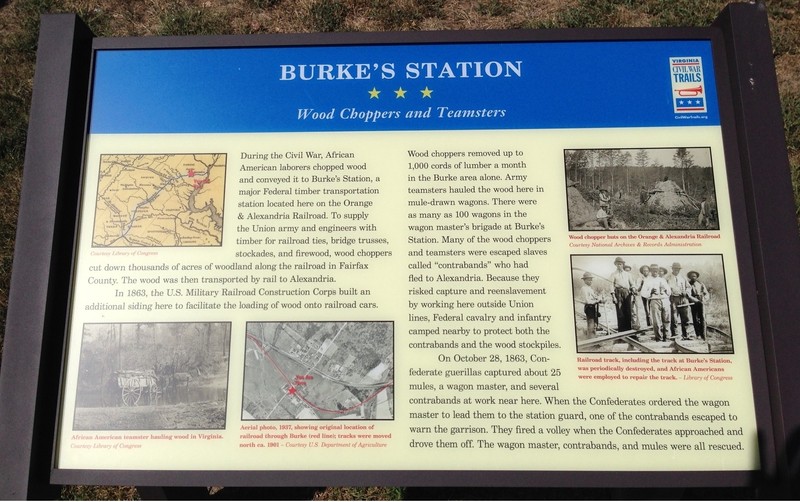
Backstory and Context
Text-to-speech Audio
Silas Burke purchased a tract of land in Fairfax County in 1824. Burke was a prominent citizen and active in the community. In 1848, he was the founding director of the Orange and Alexandria Railroad, which intended to connect Alexandria to Virginia’s existing railway system. By 1851, the tracks had reached Burke’s land; they would reach Gordonsville in 1854 and Lynchburg in 1860. A station was built near Burke’s home around 1857 and christened Burke’s Station.
The Orange and Alexandria was an important strategic target during the Civil War. Burke’s Station was seized by the Union and used largely for transporting lumber. Laborers, many of them escaped slaves (known as “contrabands”), worked in the surrounding forests as “wood choppers”. Federal wagon trains would then transport the cut timber to Burke, where it was loaded onto trains and taken to Union camps closer to Washington. There it was used to construct fortifications, railroads, and bridges, as well as for firewood. In 1863, the US Military Construction Corps built a siding in Burke to speed the loading process.
While Burke remained in Union hands for the duration of the war, it was sometimes threatened by Confederate raiders. The most famous of these occurrences was during Confederate General J.E.B. Stuart’s Christmas Raid of 1862. Stuart had previously raided Dumfries and Occoquan and was headed towards Fairfax Courthouse/Station (now Fairfax City, Virginia), where a Union force was waiting to meet him. On December 28th, a woman ran up to the station at Burke and told the telegraph operator there, J.A. Flagg, that Stuart’s forces were but a few miles away. Flagg quickly forwarded this warning to Washington and to two conductors in the area, who summarily pulled their trains back across the Accotink Bridge and to Alexandria. Flagg also found a government wagon train, operated by African Americans (possibly “contrabands”), trying to hide in the woods near Burke. Pretending to have a pistol, he threatened to shoot then ordered them to take their wagons with haste to Fairfax Courthouse, where most of the logistical forces in the area had previously been removed for protection.
Stuart arrived at Burke around seven o’clock in the evening and sent a small band of raiders to capture the station before Flagg could alert Washington or the men at Fairfax Courthouse. Stuart seized the rest of the town without a fight, as the bulk of the Federal troops had been ordered to Fairfax Courthouse. Stuart had his personal telegrapher, one Mr. Sheppard, take over from Flagg and listen in on the communications of the surrounding forces. Meanwhile, his troops tore up the Orange and Alexandria rails in the vicinity. Before midnight, he gave Sheppard an order that would send the raid down in history. Stuart requested that the following message be sent to General Montgomery C. Meigs, the Quartermaster General of the United States Army, in Washington: “General Meigs will in the future please furnish better mules; those you have furnished recently are very inferior.”[7] (The exact text of the telegram is not known, but this is how it was recorded by a contemporary Confederate soldier.) Stuart added that the mules were of such low quality that they hindered the transport of the other supplies he had captured.
Later that evening, William Holsapple, a local doctor and supposedly a Union sympathizer (it was later revealed that he had voted for secession), saw a fire at the station and, along with two sutlers, headed towards it. The men were promptly captured by Stuart’s men; though local Confederates tried to intercede for Holsapple, calling him a “quiet and peaceful man,” Stuart forced him to stand on the railroad tracks until he and his troops were out of sight. They eventually left, riding to Fairfax Courthouse; preferring to escape rather than engage with a superior force, Stuart ultimately turned south and west and headed back towards Confederate lines. (Supposedly, Stuart’s raid on Burke’s Station was the inspiration for the Confederate ballad “Riding a Raid.”)
Nearly a year later, on October 28th, 1863, a group of Confederate raiders captured a Union wagon train, consisting of 25 mules plus the wagon master and a crew of “contrabands,” in the Burke vicinity. The Confederates intended to force the wagon master to lead them to the Union garrison at Burke’s Station, which they would then capture; however, one of the “contrabands” was able to escape and warn these troops. Alerted by the warning, the Federal soldiers put the raiders to flight and recovered the wagon train.
After the war, the Orange and Alexandria Railroad was heavily damaged and in need of significant repair. Control of its lines passed to the Baltimore and Ohio Railroad in 1873 and then to the Southern Railway in 1894. Southern moved the lines north of Burke and built a new station in the early 1900s; reportedly, the old station was then rotated ninety degrees. Commuter service to the new station was discontinued in 1967, and it was torn down not long after. Yet another station, known as Burke Centre, was constructed in Pohick Park in 1972. The tracks at this station are still owned by what is now the Norfolk Southern Railroad, but the station itself is serviced by both Amtrak and the Virginia Railway Express.
Sources
1) 150th anniversary of the raid at Accotink and Burke commemorated, the Annandale Blog. December 31st 2012. Accessed June 19th 2020. https://annandaleva.blogspot.com/2012/12/150th-anniversary-of-raid-at-accotink.html.
2) Burke Centre, VA (BCV), The Great American Stations. Accessed June 19th 2020. https://www.greatamericanstations.com/stations/burke-centre-va-bcv/.
3) Burke Station, HMdb.org. August 27th 2019. Accessed June 19th 2020. https://www.hmdb.org/m.asp?m=12.
4) Doyle, Brian. Back in the Day: Burke Station Raid, Patch: Burke, VA. October 27th 2010. Accessed June 19th 2020. https://patch.com/virginia/burke/burke-station-raid.
5) Fisher, Bernard. Burke's Station: The Christmas Raid, HMdb.org. June 16th 2016. Accessed June 19th 2020. https://www.hmdb.org/m.asp?m=83049.
6) Fisher, Bernard. Burke's Station: Wood Choppers and Teamsters, HMdb.org. July 3rd 2016. Accessed June 19th 2020. https://www.hmdb.org/m.asp?m=88520.
7) Orrison, Rob. “…please furnish better mules…”— JEB Stuart’s 1862 Christmas Raid, Part One, Emerging Civil War. December 26th 2014. Accessed June 19th 2020. http://emergingcivilwar.com/2014/12/26/please-furnish-better-mules-jeb-stuarts-1862-christmas-raid/.
8) Orrison, Rob. “…please furnish better mules…”— JEB Stuart’s 1862 Christmas Raid, Part Two, Emerging Civil War. December 30th 2014. Accessed June 19th 2020. http://emergingcivilwar.com/2014/12/30/please-furnish-better-mules-jeb-stuarts-1862-christmas-raid-part-2/.
9) Randolph, J. W. Riding a Raid (Notated Music), Library of Congress. Accessed June 19th 2020. https://www.loc.gov/item/ihas.200002526/.
10) Vrana, J. and M. Lipsey. Stuart's Christmas Raid: Burke, Virginia: Dec. 28, 1862, Fairfax Station Railroad Museum. 2013. Accessed June 19th 2020. https://fairfax-station.org/pdfs/Stuart%20raid.pdf.
On HMdb.org (https://www.hmdb.org/PhotoFullSize.asp?PhotoID=4)
By William Barnard on HMdb.org (https://www.hmdb.org/PhotoFullSize.asp?PhotoID=307391)
By William Barnard on HMdb.org (https://www.hmdb.org/PhotoFullSize.asp?PhotoID=307389)
By J.J. Prats on HMdb.org (https://www.hmdb.org/PhotoFullSize.asp?PhotoID=3)
On HMdb.org (https://www.hmdb.org/PhotoFullSize.asp?PhotoID=328780)
